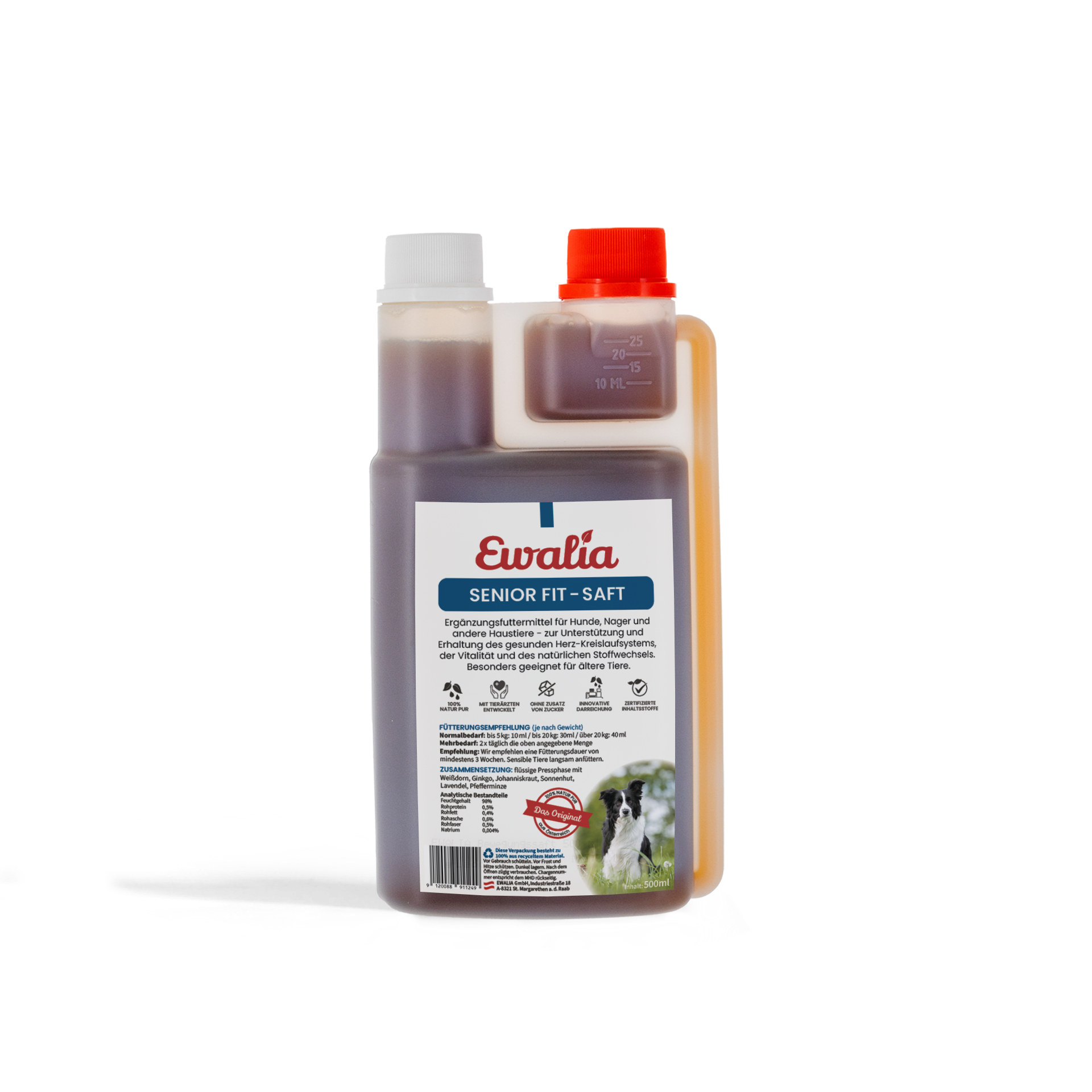Ginseng

In its native regions of the Far East, ginseng (Panax ginseng) is said to have life-extending and rejuvenating properties. Indeed, ginseng root contains substances that stimulate metabolism and the immune system and help to relieve stress and exhaustion. Ginseng is a valuable aid against fatigue and weakness and helps to increase well-being, especially in older dogs.
Where does ginseng come from, and what does it look like?
Ginseng is native to the shady mountain forests of Korea and Manchuria. This perennial, herbaceous plant belongs to the Araliaceae family and is thus related to our local species of ivy. It grows between 30 and 80 cm high and can apparently live 100 years. The aerial part of the ginseng plant is rather unassuming. It has a round, upright stem bearing three to six strongly serrated ovate leaves that are hairy on the underside.
Wild ginseng grows quite slowly. The plant waits three years to form yellowish-white or greenish-white flower umbels on a stem, flowering from June to July. The flowers put forth bright red, berry-like fruits that are about the size of a pea; these contain the kidney-shaped seeds.
In its native regions, ginseng has been used as a medicinal plant since ancient times. Legend has it that ginseng was first cultivated 1,500 years ago to meet rising demand for the "all-healing" root.
Today it is cultivated on plantations in China, Korea, Japan, and Russia. The root can be harvested four years after planting at the earliest, and the older the plant, the more substances are contained in the root. Large roots from plants that are ten years old or more bring accordingly higher prices. In the wild, it would take a root several decades to grow to about 12 cm long!
The first ginseng plantations in Central Europe were established in the 1980s, and include farms in Germany (Lüneburg Heath) and Switzerland. This miracle root has also been cultivated in Austria's Waldviertel region since 1999.
Which parts of ginseng are used in phytotherapy?
Ginseng's active substances are found in its light-coloured, oddly shaped roots (Ginseng radix). The firm, turnip-like root splits into two or more main parts with numerous secondary roots, somewhat resembling a human torso with limbs and often sporting a "head" as well. Its Chinese name translates roughly into "human root". The roots, which are dug up in autumn, have a somewhat unusual smell and an initially bitter taste. However, after they are chewed longer, they turn sweet and a little bit slimy.
There are two ways to preserve ginseng root: white ginseng is washed, peeled, and dried in the sun.
Red ginseng is produced by steaming the root before it is dried. The drying process will cause the root to harden and change colour. Red ginseng will keep for at least a year but contains fewer active substances than white ginseng.
It is therefore white ginseng that is primarily used in medicinal products. The roots are processed into powders, tinctures, and liquid extracts. Dried ginseng root can also be used to make tea. Because the active ingredient content of ginseng depends on the quality and age of the root, it is difficult to determine a correct quantity. It is therefore recommended that standardised products be used.
Ginseng's effects are gradual, and so it should be administered over a longer time period.
What is ginseng used for?
Ginseng is considered the most important medicinal plant of the Far East. In traditional Chinese medicine, ginseng root is used to treat weakness and to strengthen the body's natural defences. It is used to boost energy flow ("qi") and can also be taken to soothe coughing up blood, stomach ailments and even poisoning.
The "human root" was first introduced to Europe by Dutch seafarers in the 17th century. Ginseng was soon viewed as an exotic miracle herb from the East that could be used to counter ageing and frailty and as a tonic and aphrodisiac. It was in great demand in courtly circles, particularly at the court of the "Sun King", Louis IV of France. There, this exotic plant was considered more valuable than gold, and far beyond the means of the country's population.
Ginseng root became obtainable when it began to be cultivated locally. It was adopted in local folk medicine and was considered an effective remedy for cold limbs, emaciation, loss of appetite, and impotence.
The plant's numerous effects have been examined in several international scientific studies. Ginseng extracts have been shown to have defence-boosting and adaptogenic properties, meaning that they increase the organism's ability to adapt to special challenges like stress. They enhance physical and mental performance and help combat fatigue.
In veterinary medicine, ginseng is mainly used as a tonic for weak, old, or convalescent animals.
What are ginseng's active substances?
Ginseng contains saponins called ginsenosides, soap-like substances found in many plants. In water, these produce lather to ward off infections and pests. The essential properties of ginsenosides are scientifically proven. They:
- boost the immune system
- boost metabolism
- boost physical and mental performance
Ginseng also contains essential oils, phenolic acids and polysaccharides. It is this combination of substances that gives ginseng root its antioxidant and anti-inflammatory effects. Laboratory tests have found that some of the substances in Ginseng promote vasoconstriction and thus stimulate circulation whilst others help to lower blood sugar levels.
What canine ailments can ginseng be used to treat?
You can use ginseng to support your dog's immune system in stressful times, such as when he is shedding, emotionally excited or stressed, or following illness. Ginseng can enhance your dog's well-being and can help him to adapt mentally and physically to new or challenging situations.
Ginseng helps older dogs with physical weakness, cardiovascular weakness and general fatigue, and can help ageing dogs to enjoy improved fitness and quality of life.
Senior dogs often suffer from adjustment disorders in old age, meaning that they lose their ability to adapt to changes in their environment quickly and flexibly and compensate for stress. This loss is a burden to their psychological well-being as well as to their immune systems! It results in insecurity, exhaustion, behavioural changes, and increased susceptibility to infection. A regimen of ginseng preparations can help your dog cope with changes due to ageing and strengthen his immune system at the same time!
Adverse effects:
Ginseng is generally well tolerated. Highly sensitive animals may experience gastrointestinal issues or nervousness.
Important: Use extreme caution when feeding ginseng to nervous, fidgety dogs! Consult your vet before feeding pure ginseng preparations to dogs with diabetes!
Ginseng regimens should last for at least three to four weeks but no longer than three months without pause. Please follow the manufacturer's instructions!
Sources
- Cäcilia Brendieck-Worm, Matthias F. Melzig: Phytotherapie in der Tiermedizin, Thieme 2018
- J. Reichling, R. Gachnian-Mirtscheva, M. Frater-Schröder, R. Saller, M. I. Rabinovich, W. Widmaier: Heilpflanzenkunde für die Veterinärpraxis, Springer 2008
- https://arzneipflanzenlexikon.info/ginseng.php
- https://www.deutsche-apotheker-zeitung.de/news/artikel/2018/09/03/ginseng-wurzel-fuer-mehr-lebenskraft
- Stephen Dammer: Heilpflanzen in der Veterinärmedizin, Faculty of Veterinary Science, Szent Istvan University Department of Botany, 2013
- (=http://www.huveta.hu/bitstream/handle/10832/853/StephenDammerThesis.pdf?sequence=1&isAllowed=y)















